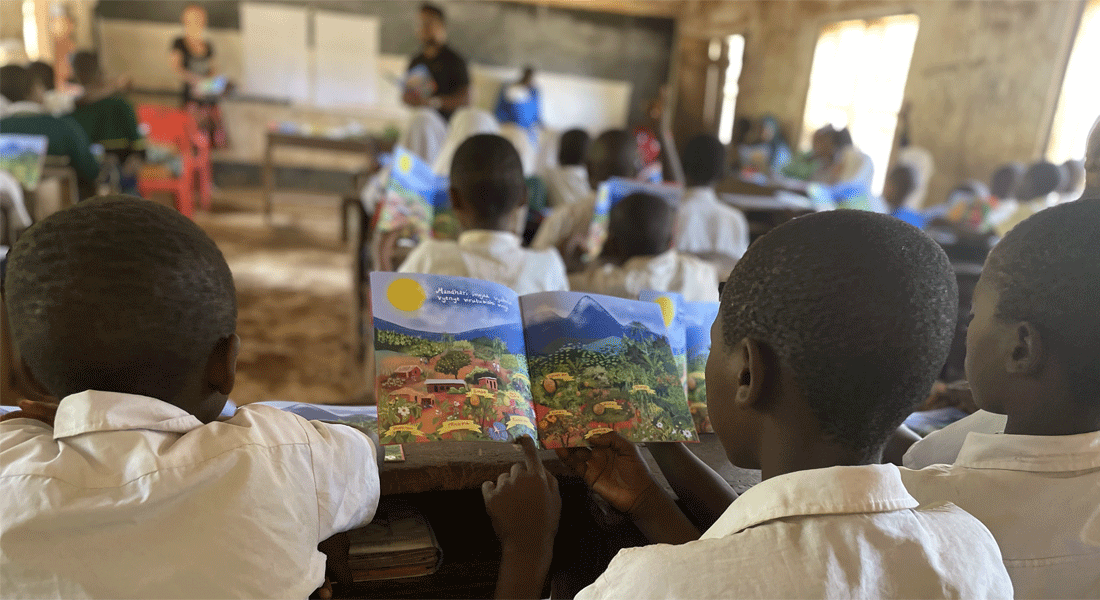Turning data into drawings: distributing children’s books on wild forest foods in East Africa

Research on how to improve food and nutrition security has the potential to make real-life contributions for local communities suffering from nutrient deficiencies. Yet, most research remains inaccessible to people who could benefit from it. To elevate the impacts of research beyond a scientific paper, the ERC funded project FORESTDIET has developed and distributed a children’s book on wild foods in Malawi and Tanzania.
The book My Little Guide to Wild Food contents are based on results obtained from data on wild food consumption in Malawi and Tanzania, collected by PhD students Emilie Vansant and Rasmus Skov Olesen. Together they surveyed more than 1000 households across 16 sites in the two countries.
The book is designed to educate young children in rural Africa about how wild foods from the forest can contribute to healthy diets. The illustrations were developed in collaboration with graphic facilitator Mette Jeppesen and highlight the importance of consuming foods rich in micronutrients, such as Vitamin A. To better acquaint children with their surrounding landscape, it features common tree species (e.g. wild custard apple, wild java plum) and green leafy plants (e.g. wild cow peas, black jack) and their various functions, including providing nutrient-rich fruits and vegetables.
The team, which consists of Emilie, Rasmus, postdocs Bowy den Braber and Charlotte Hall, Associate Professor Laura Vang Rasmussen, and graphic facilitator Mette Jeppesen from Tanke-Streger, traveled to Tanzania and Malawi in March 2023 and distributed the book to ~1500 children across 16 schools through interactive workshops designed to engage students with the book’s contents.

The team published the book in three languages: English, Chichewa and Swahili. When distributing the book to school children, the book was first read out loud to the children with the help of local research assistants. Mette sketched a human body and explained how eating nutritious fruits and vegetables can be good for your eyesight, strength and health. The workshops finished with a drawing activity, where the children were invited to pick certain leaves and fruits to draw together on large sheets of paper. These collective ‘nutritious landscape drawings’ were then left to decorate the classrooms.
In summary, the FORESTDIET team found it very rewarding to be able to give the research findings back to the communities. Finding ways to improve people’s food security and nutrition is key - especially in Malawi where cyclone Freddy, one of the worst cyclones ever recorded in the Southern hemisphere, slammed the country while the team was trying to conduct the workshops. Despite heavy rains and schools being suspended, the team and local partners managed to organize makeshift workshops for children in the villages. Even under these conditions, the team was warmly received by the local chiefs and children.


In the classroom, the children have finished reading, and now they have to draw. Before long, the room is full of beautiful drawings, and the children leave the room with new knowledge about plants and fruits. Photo: Laura Vang Rasmussen, IGN.
You can finde the book My Little Guide to Wild Food online here
March 21 is International Forest Day
The UN has declared March 21 International Forest Day. The day aims to celebrate and raise awareness of how important forests are. On Forest Day, countries are encouraged to undertake local, national and international efforts to organize activities involving forests and trees. The theme for 2023 is "Forest and health."
About the FORESTDIET project
The project runs until 2025 and is financed by the European Research Council. The project aims to uncover the connection between changes in forest cover and the quality of people's diets in low-income countries.
Contact
Laura Vang Rasmussen
Associate Professor - Promotion Programme
lr@ign.ku.dk
+45 35 32 58 60
Anette Bill-Jessen
Kommunikationskoordinator
anbj@ign.ku.dk
+45 93 51 13 70
